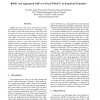Free Online Productivity Tools
i2Speak
i2Symbol
i2OCR
iTex2Img
iWeb2Print
iWeb2Shot
i2Type
iPdf2Split
iPdf2Merge
i2Bopomofo
i2Arabic
i2Style
i2Image
i2PDF
iLatex2Rtf
Sci2ools
ISCC
2008
IEEE
2008
IEEE
ROHC and aggregated VoIP over fixed WiMAX: An empirical evaluation
WiMAX has been at the center of attention in wireless communications during the last years. Nonetheless, very few testbed or field trial measurement accounts have been reported in the peer-reviewed literature. We fill this gap by exploring scenarios where fixed WiMAX is employed for VoIP traffic. VoIP packets typically exhibit large header overheads and small total packet sizes. The actual codec payload per packet is very small compared to the total length of headers appended to each voice frame. RObust Header Compression (ROHC) can significantly decrease header size by capitalizing on static or rarely changing header fields. Aggregating multiple voice frames into one packet is another attractive and effective way to increase application goodput and overall bandwidth utilization. We study the effect of ROHC and application layer aggregation on VoIP performance in a fixed WiMAX testbed consisting of one base station and two subscriber stations. We find that ROHC increases the n...
Communications | ISCC 2008 | ROHC | VoIP | WiMAX |
| Added | 31 May 2010 |
| Updated | 31 May 2010 |
| Type | Conference |
| Year | 2008 |
| Where | ISCC |
| Authors | Esa Piri, Jarno Pinola, Frerk Fitzek, Kostas Pentikousis |
Comments (0)

